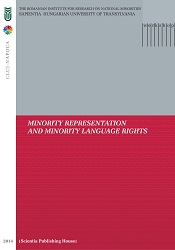Being in Minority or Majority? The Transylvanian Party in the Hungarian Public Life Between 1940 and 1944
Being in Minority or Majority? The Transylvanian Party in the Hungarian Public Life Between 1940 and 1944
Author(s): János Kristóf Murádin
Subject(s): Politics / Political Sciences, Law, Constitution, Jurisprudence
Published by: Scientia Kiadó
Summary/Abstract: This paper deals with an unfairly forgotten party, trying to give a thorough picture of the Transylvanian Party which collected the Hungarians from Northern Transylvania together. There have been many attempts to hold the Hungarian community together and represent it politically after breaking away from Hungary in 1920. These attempts are already known today but not the activity of the Transylvanian Party between 1940 and 1944. This political configuration was the only Hungarian party from Transylvania in the last century that activated within the frame of the Hungarian State. It is thus a unique political party that was founded in the period when Hungarians represented the majority, but its operating mechanisms, its objectives and instruments had a ‘minority’ character going beyond regionalism, being an organic part of the Hungarian national political life. Its main objective was to hold the Hungarians of Transylvania together, to represent the Transylvanians in the Hungarian Parliament and to mediate between the local Romanian, German and Jew nationalities and the Hungarian government. The Transylvanian Party tried to reach a dominant position in the region in order to stop the expansion of the Hungarian, mainly extreme, right parties in Transylvania, and became the most comprehensive party in Transylvania. Among the 1,340,000 inhabitants of Northern Transylvania, 243,500 were active members of the party in 1942. My discourse concentrates on the founding, the building up of the party structure and the analysis of the party programme, with special focus on the basic conception of the party regarding ethnic problems in Transylvania. I also deal with the opinion of the Northern Transylvanian Hungarian community regarding this political configuration. At the end, I sketch in the cessation of the party and its intellectual legacy, which is relevant and useful even today.
Book: MINORITY REPRESENTATION AND MINORITY LANGUAGE RIGHTS
- Page Range: 171-187
- Page Count: 17
- Publication Year: 2014
- Language: English
- Content File-PDF

